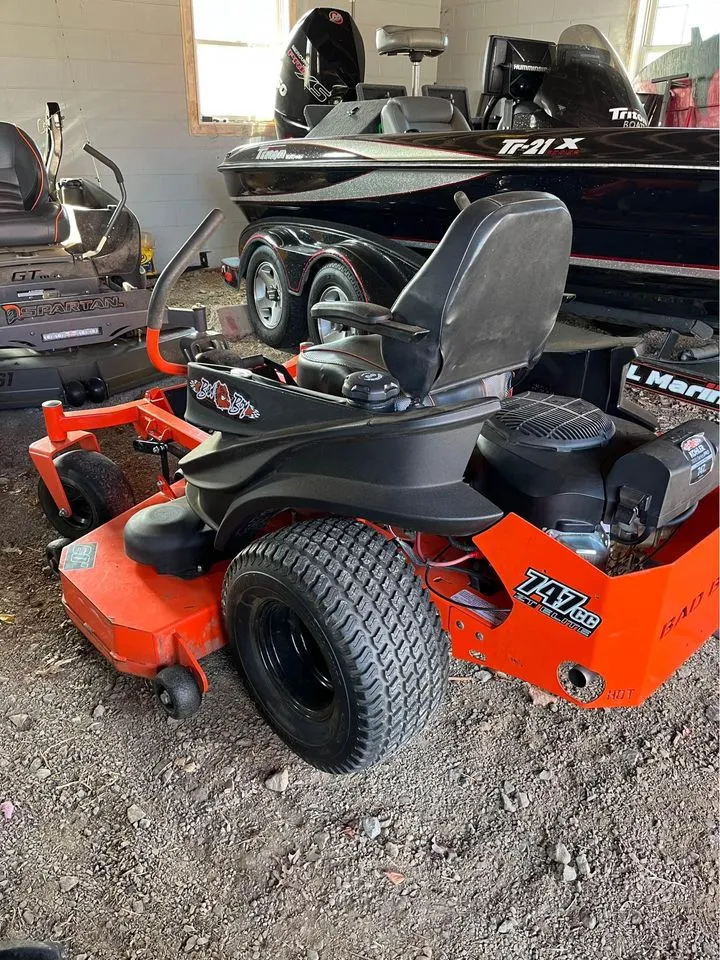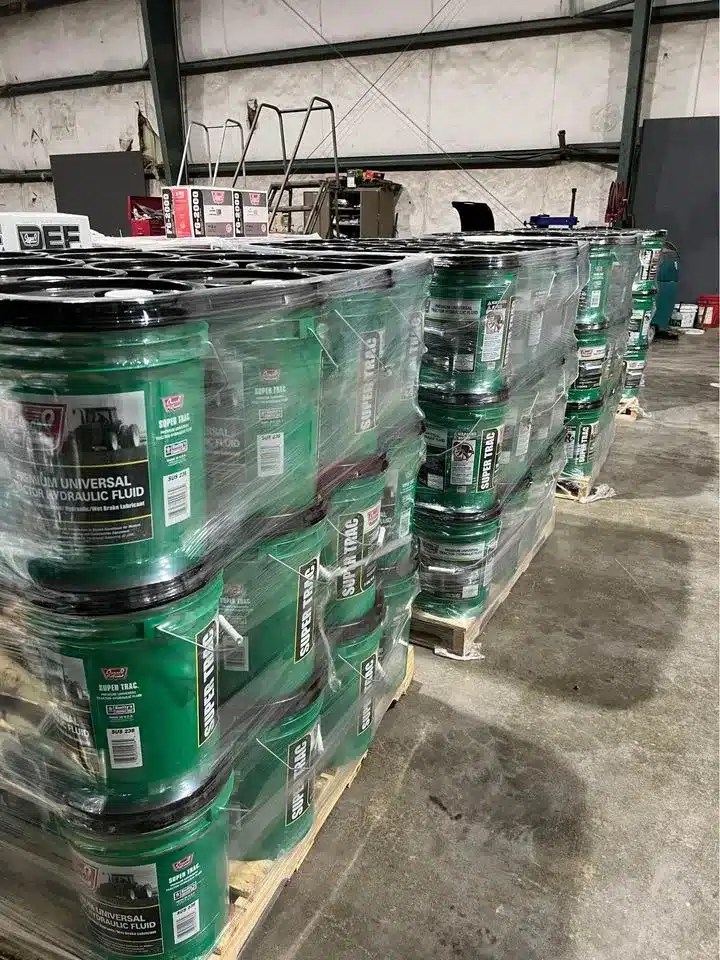Preparing your zero turn mower for the winter months is essential to ensure its longevity and optimal performance.
With years of experience in lawn care equipment maintenance, I’ve refined a comprehensive winterization process that safeguards your mower against the damages of cold weather.
By following my expert advice, you can maintain your mower in prime condition and avoid costly repairs or replacements come spring.
In this guide, I’ll walk you through each critical step, from fuel treatment to battery preservation, to protect your investment.
Trust in my proven techniques and read on to learn how to effectively winterize your zero turn mower, keeping it ready for action when the seasons change.
Quick Summary
- Winterizing a zero turn mower involves steps like stabilizing fuel, removing the battery, and changing the oil to ensure its optimal performance during colder months.
- The process includes detailed tasks such as cleaning and lubricating the mower, sharpening blades, and preparing it for storage.
- Proper winterization can statistically extend the lifespan of a zero turn mower by preventing weather-related damages.
- In my opinion, dedicating time to winterize a mower is a valuable investment for maintaining a beautiful lawn and ensuring the mower’s longevity.
Here’s How To Winterize Your Zero Turn Mower
As the chill of winter sets in, it’s time I prepare my zero turn mower for the cold months ahead.
I’ll start by either removing the fuel or adding a stabilizer to it, ensuring it doesn’t degrade and clog the system.
Next, I’ll take out the battery and spark plug, and then move onto replacing or cleaning the filters and changing the oil.
Remove or Stabilize the Fuel
- Remove remaining fuel or add a stabilizer to prevent deterioration.
- Adding a quality fuel stabilizer to the tank is recommended.
- Run the engine for a few minutes to circulate stabilized fuel.
- Alternatively, run the mower until it’s out of gas if removing the fuel.
Take Out the Battery
- Ensure the mower’s engine is off and the key is removed.
- Locate the battery (usually under the seat or behind a panel).
- Disconnect the negative cable first, then the positive cable.
- Lift and store the battery in a cool, dry place.
- Use a trickle charger to maintain the battery’s charge.
Remove the Spark Plug
- Wait until the engine is cool before starting.
- Locate and carefully disconnect the spark plug wire.
- Use a spark plug socket and ratchet to unscrew the spark plug.
- Inspect the spark plug for wear or buildup.
- Store the spark plug in a dry place to prevent accidental combustion.
Replace or Clean Filters
- Ensure filters are either replaced or thoroughly cleaned for optimal air and fuel flow.
- Remove the air filter and tap out loose dirt. Replace it if excessively dirty or damaged.
- Check the fuel filter for sediment or residue. Replace if contaminated.
- Remember that clean filters are key to the longevity and efficiency of the engine.
Change the Oil
- Crucial to change oil before winter to remove contaminants.
- Warm up the engine to make oil draining easier.
- Locate the oil drain plug, place a container for old oil, and carefully remove the plug.
- After draining, replace the plug and fill the engine with fresh oil.
- Replace the oil filter as well.
- Run the engine briefly to circulate the new oil.
Scrape the Mowing Deck
- Clean the mowing deck of grass clippings and debris.
- Scrape off any buildup to prevent moisture retention and rust.
- Lift the deck or tip the mower for easier access.
- Use a putty knife or deck-cleaning tool to remove gunk.
- Rinse and dry the deck thoroughly after cleaning.
Sharpen the Blades
- Sharpen the mower blades to maintain cutting efficiency.
- Disconnect the spark plug before starting.
- Remove the blades and sharpen them, following the original angle.
- Check for balance and reinstall the blades.
Clean and Lube the Mower
- Thoroughly clean the mower with a brush and detergent.
- Pay attention to the undercarriage.
- Apply lubricant to pivot points, bearings, and spindles.
- Grease the caster wheels and hubs.
- Ensure the mower deck is free from debris and obstructions.
Storage Tips

Once your zero turn mower is clean and the moving parts are well-lubricated, it’s time to focus on proper storage methods to protect your investment during the cold months.
First, I make sure to stabilize the fuel, which keeps the gasoline from degrading. Then, I change the oil and oil filter to ensure the engine remains in good shape.
I don’t forget about the battery; I either remove it or connect it to a trickle charger to prevent discharge. I also check for any worn belts or blades and replace them as necessary.
Preparation for Storage
Properly preparing your zero turn mower for storage is key to maintaining its condition.
This includes disconnecting the axle using pull pins for easy movement, applying a silicone protectant to prevent rust and deterioration, and wiping down the mower with a microfiber towel.
Choosing the right storage location is also critical – a covered area like a garage is ideal to protect the mower from cold and moisture. These steps ensure that your mower remains in good condition throughout the winter months.
Problems Caused by Lack of Winterization
Neglecting to winterize your zero turn lawn mower can lead to a host of problems. Without proper care, the engine can suffer from corrosion due to moisture and condensation, leading to internal component damage.
Old gas left in the fuel system can degrade and clog carburetors. Come spring, you might face major repair bills or even the need for a total replacement.
This not only leads to unnecessary expenses but also to the frustration of dealing with a non-functional mower when it’s needed most.
Additional Tips For Success
When it comes to winterizing your zero turn mower, it’s not just about the standard steps of changing oil or cleaning the air filters.
There are a few more advanced, yet equally important, practices that can significantly enhance the longevity and performance of your mower. These additional tips delve into some often-overlooked areas of mower maintenance.
By implementing these strategies, you can ensure your mower remains in top condition, ready to tackle your lawn with ease come spring. Let’s explore these advanced techniques that could make a big difference in your mower’s upkeep.
Hydraulic Oil and Filter Change

An often overlooked but crucial step in winterizing your zero turn mower is changing the hydraulic oil and filter. This is especially important for machines with serviceable hydraulic systems.
Neglecting this can lead to weakened mower performance and damage to the transmission. The process involves parking the mower on a flat surface, locating and cleaning the filters, draining the old oil, and then filling with fresh hydraulic oil.
Each model may have different procedures, so consulting your manual is vital. Remember, most manufacturers recommend an initial oil change after a break-in period, which is sometimes as early as 75 hours of use.
Related: Husqvarna Zero Turn Hydraulic Fluid Change: Tips
Fogging the Engine
To protect the internal components of your mower’s engine during the off-season, fogging the engine is a highly effective method.
This involves running the engine while applying fogging oil to the throttle body, allowing the oil to coat the internal parts and prevent corrosion. It’s a simple yet impactful step that can significantly extend the life of your engine.
This process should be done while the engine is running until the fuel is completely used up, ensuring thorough protection.
Quarter-inch Shutoff Valve Installation
Installing a quarter-inch shutoff valve in the fuel system is a proactive measure to avoid fuel-related issues during storage. This valve helps in cutting off the fuel supply, which is particularly useful when the mower is not in use for extended periods, like winter.
It prevents the fuel from stagnating and gumming up the system, ensuring that your mower is ready to use when spring arrives. This is a simple yet effective step towards maintaining your mower’s fuel system health.
Our Verdict
In my experience, the effort put into winterizing a zero turn mower is an investment that pays off handsomely. Through these steps, I’ve consistently ensured my mower’s readiness for spring, dodging any frustrating start-up issues.
By taking the time now to care for your mower – from fuel treatment to sharpening blades – you’re not just preserving a piece of equipment; you’re safeguarding your ease of lawn care in the seasons to come.
I’ve seen firsthand how regular maintenance extends a mower’s lifespan and prevents costly repairs.
So, here’s my verdict: embrace these winterizing steps. It’s a satisfying task that promises a smooth start to your mowing season and keeps your lawn looking its best. Happy winterizing!
Frequently Asked Questions
Can I use the same fuel stabilizer for my zero turn mower as i use for other power equipment?
Yes, I can use the same fuel stabilizer for my zero-turn mower as I do for my other power equipment to keep the gasoline from deteriorating during storage.
What are the risks of not removing the battery from my zero turn mower before winter storage?
I risk my mower’s battery discharging or even freezing if I don’t remove it before winter. That could leave me with a dead battery or worse, needing a replacement when spring arrives.
Is it safe to store my zero turn mower in an outdoor shed during the winter months?
I’ll store my zero turn mower in an outdoor shed for winter, but I’ll make sure it’s weatherproof to protect against moisture and cold that could damage the mower’s parts.
How often should I check on my zero turn mower during the off-season to ensure it remains in good condition?
I usually check on my mower monthly during the off-season to ensure it stays in good shape. Regular inspections prevent any unwelcome surprises when it’s time to mow again.
Can I use a cover for my zero turn mower while it’s stored, and if so, what type of cover is recommended?
I can use a cover for my mower during storage. A breathable, water-resistant cover is best to prevent moisture buildup and rust while keeping dust and debris off my equipment.


